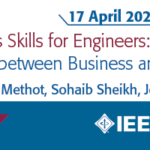The Third IEEE Milestone Recognition of India
Harish Mysore, Sr. Director for IEEE India Operations

During the dedication ceremony, a bronze plaque commemorating the recognition of IEEE Milestone was handed over to India’s National Centre for Radio Physics (NCRA) by IEEE on 30th March, 2021. The plaque was virtually unveiled by Mr. K.N. Vyas, Secretary, Department of Atomic Energy and Chairman of the Atomic Energy Commission. On this occasion, Honorable Prime Minister of India, Mr. Narendra Modi, through his letter, congratulated scientists and engineers of Giant Metre Wave Radio Telescope (GMRT) for this global recognition and recalled India’s glorious tradition in astronomy dating thousands of years back and added that the GMRT is a shining example of “Atmanirbhar Bharat” (Self Reliant India). Milestones recognize technological innovation and excellence for the benefit of humanity. Milestone recognizes significant technical achievement that occurred at least twenty-five years ago and has a regional impact.
Prof. Govind Swarup, during the period 1984 to 1996, conceived and directed the design and construction of GMRT. GMRT consists of 30 large fully steerable antennas (each 45m diameter), spread out over a 25km region, about 80km from Pune in the state of Maharashtra in India. His innovative design was crucial to allow the construction of a world-class telescope at a very modest cost. The GMRT remains one of the most sensitive radio observatories in the world in the frequency range of 130 – 1450 MHz, attracting users from all over the world and producing a slew of cutting edge science results, pioneering new techniques in antenna design, receiver systems, and signal transport over optical fiber. GMRT has produced important discoveries in domains such as pulsars, supernovae, galaxies, quasars, and cosmology, greatly enhancing our understanding of the Universe. Prof. Swarupbecame was the project director of the GMRT in 1987, and when his group in Tata Institute of Fundamental Research (TIFR) became the National Centre for Radio Astrophysics (NCRA) as part of TIFR, he became its first Centre Director in 1993. He was a strong proponent of building up scientific capacity in the country and played an important early role in conceptualizing the setting up of the Indian Institutes of Science, Education & Research (IISER).
With this recognition, GMRT became the third IEEE Milestone in India along with “First Millimetre-Wave Communication Experiment” by Acharya J. C. Bose in 1894-1896, and “Raman Effect”, by Sir C. V. Raman in 1928. IEEE Pune Section Chair, while handing over the bronze plaque to NCRA Director said “It is a great honor to everyone in the section that Pune is the host for the third IEEE Milestone in India”. Accepting the milestone plaque, Prof Yashwant Gupta, Director, NCRA said, “This IEEE Milestone status puts our observatory truly in a very special league and is a moment of great pride and joy for all of us at NCRA & entire scientific and technical community of India.”
IEEE ED & COO, Steve Welby gave an overview, followed by an announcement by Prof. Toshio Fukuda, President & CEO 2020 that GMRT is an IEEE Milestone and added that this recognition of GMRT Serves as a landmark of technology. Dr. Janina Mezierska, Chair for History Committee informed that there are 234 IEEE Milestones around the world and 18 awaiting dedications. GMRT, Pune is the third IEEE Milestone in India and 42nd in Region 10. Other Milestones in R10 include 38 in Japan & one in Australia. Mr. Deepak Mathur, IEEE Region 10 Director also spoke on the occasion. He highlighted the strength of Region 10 and the contributions of India in its growth. He commented that India and other countries in Region 10 have great potential and we should expect more of such milestone recognitions in the near future.
Others who spoke on the occasion were Prof K. Vijay Raghavan, Principal Scientific Advisor to Government of India; Mr. Prakash Javadekar, Minister for Environment, Forest & Climate change, Information & Broadcasting (through a letter of appreciation); Mr. K. Ramchand, Member-Technology, Department of Telecommunications; Prof. S Ramakrishnan, Director, TIFR,; Dr. Anil Kakodkar, former Chairman of Atomic Energy Commission of India; Dr. R. A. Mashelkar, former Director General of CSIR; Prof. K Kasturi Rangan, former Chairman, Indian Space Research Organization (ISRO) and present Chancellor of Central University of Rajasthan and NIIT University, and Prof. Jayant Narlikar, noted astrophysicist and emeritus professor at Inter- University Centre for Astronomy and Astrophysics. All the speakers recognized and lauded the achievements of the GMRT, while recollecting the contributions of Prof Govind Swarup.



